La teoria dei colori è estremamente importante per chiunque voglia realizzare fantastici ricami a macchina. Quando capisci la teoria dei colori, puoi scegliere colori che stanno benissimo insieme e far risaltare i tuoi disegni!
Questa guida ti aiuterà ad apprendere le basi della teoria dei colori, come il modo in cui i colori si mescolano, come mescolarli, e quali sensazioni possono creare i diversi colori.
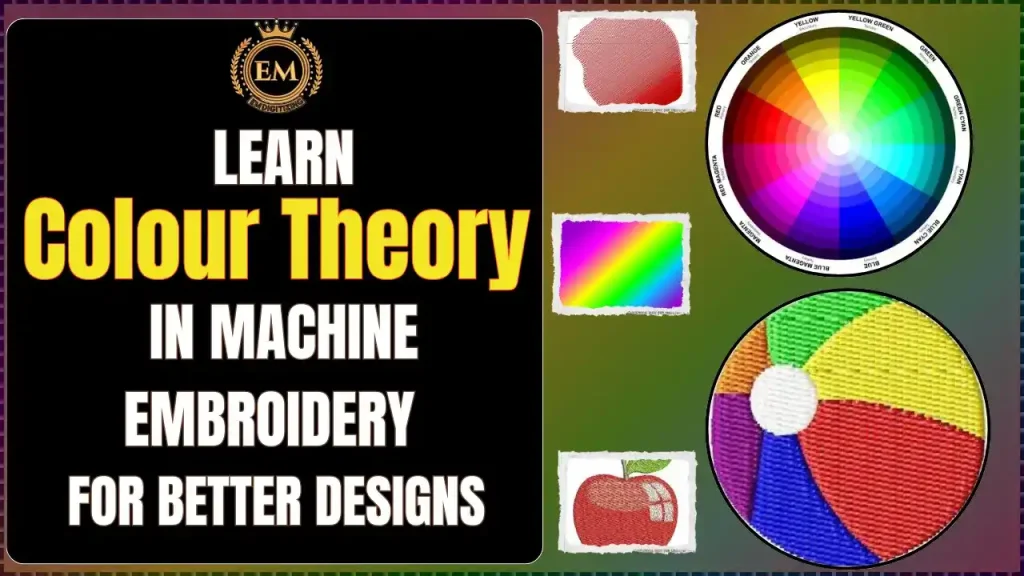
Conoscere il colore ti aiuterà a scegliere i colori migliori per i tuoi progetti, quindi sembrano fantastici! Whether you’;stai appena iniziando o vuoi migliorare, imparare queste idee sui colori renderà i tuoi ricami più divertenti e ti aiuterà a creare disegni straordinari!
Impara la teoria dei colori nel ricamo a macchina per progetti migliori
Concetti chiave sui colori per le ricamatrici
Comprendere la teoria dei colori è essenziale per creare oggetti belli disegni da ricamo. Ecco alcuni concetti importanti spiegati in termini semplici:
- Tinta: Il nome specifico di un colore, come il rosso, blu, o verde, indicando la sua posizione sulla ruota dei colori.
- Tono: Questo viene creato mescolando il grigio con un colore, che ne attenua la luminosità e l'intensità.
- Ombra: Una sfumatura si verifica quando al colore viene aggiunto il nero, risultando in una versione più scura. Ad esempio, mescolando il nero con il rosso si ottiene il rosso scuro.
- Tinta: Una tinta si forma aggiungendo il bianco a un colore, rendendolo più leggero. Un esempio di questo è il rosa, che è una sfumatura di rosso.
- Saturazione: Questo termine descrive quanto è brillante o vivido un colore. I colori altamente saturi appaiono luminosi, mentre i colori meno saturi appaiono sbiaditi.
- Colori primari: I tre colori principali: rosso, blu, e il giallo, che non può essere ottenuto mescolando altri colori.
- Colori secondari: Questi colori risultano dalla miscelazione di due colori primari. Per esempio, combinando rosso e blu si ottiene il viola.
- Colori terziari: Questi si formano mescolando un colore primario con un colore secondario. Un esempio è mescolare il blu e il verde per ottenere il blu-verde.
- Tabella dei colori Pantone: Una guida colori standardizzata ampiamente utilizzata in settori come il ricamo, garantendo un utilizzo coerente del colore nei vari progetti.
La ruota dei colori nel ricamo a macchina
Il colore del ricamo la ruota è uno strumento potente per chiunque sia coinvolto nel ricamo a macchina. Ti aiuta a capire come i colori lavorano insieme, rendendo più semplice la creazione di bellissimi disegni.
Ecco come puoi utilizzare la ruota dei colori nei tuoi progetti:
Primario, Secondario, e colori terziari
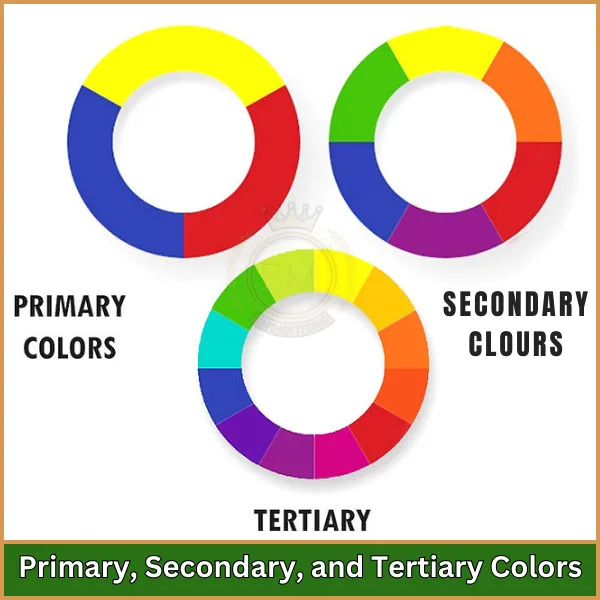
- La ruota dei colori inizia con tre colori primari: rosso, blu, e giallo. Questi colori non possono essere creati mescolando altri.
- Quando mescoli due colori primari, ottieni i colori secondari. Per esempio, il rosso e il blu si mescolano per creare il viola, mentre il blu e il giallo si mescolano per creare il verde.
- I colori terziari si ottengono mescolando un colore primario con un colore secondario. Un esempio è il blu-verde, che deriva dalla miscelazione del blu e del verde. Conoscere queste relazioni aiuta a scegliere le tavolozze dei colori del ricamo.
Colori complementari
I colori complementari sono quelli che si trovano uno di fronte all’altro sulla ruota dei colori, come rosso e verde o blu e arancione. L'uso di colori complementari nei tuoi progetti crea un forte contrasto, fai risaltare il tuo ricamo e attira l'attenzione.
Colori triadici
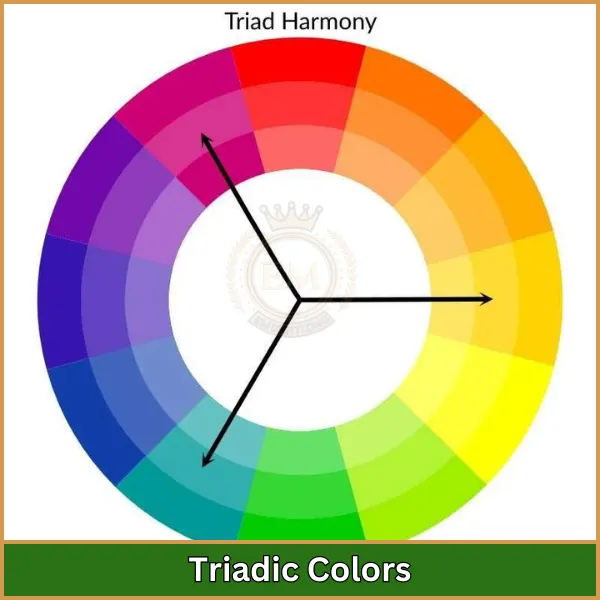
I colori triadici sono distribuiti uniformemente attorno alla ruota dei colori, come il rosso, giallo, e blu.
Questa combinazione fornisce una combinazione di colori vibranti ed equilibrati, ideale per progettazioni vivaci e dinamiche.
Colori analoghi
I colori analoghi sono uno accanto all'altro sulla ruota dei colori, come il blu, blu-verde, e verde. Questi colori creano un aspetto armonioso, spesso presenti in natura, e sono ottimi per rendere i tuoi progetti più coesi e rilassanti. Questo approccio è essenziale nella cucitura a macchina e nell'armonia dei colori.
Valore e saturazione nel ricamo
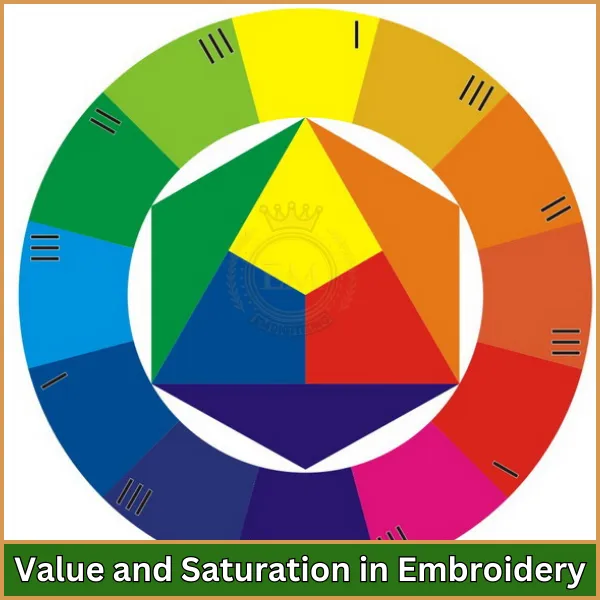
Il valore si riferisce a quanto è chiaro o scuro un colore, mentre la saturazione indica quanto luminoso o vivido appare il colore. Regolando il valore e la saturazione del tuo colori del filo, puoi aggiungere profondità e dimensione al tuo ricamo, migliorando l'impatto complessivo del tuo design.
Contrasto e valore nel design
La teoria dei colori del ricamo a macchina è essenziale per capire come creare disegni accattivanti. Nel ricamo, comprendere il contrasto e il valore è fondamentale per far risaltare i tuoi progetti e sembrare più professionali.
Cos'è il contrasto?
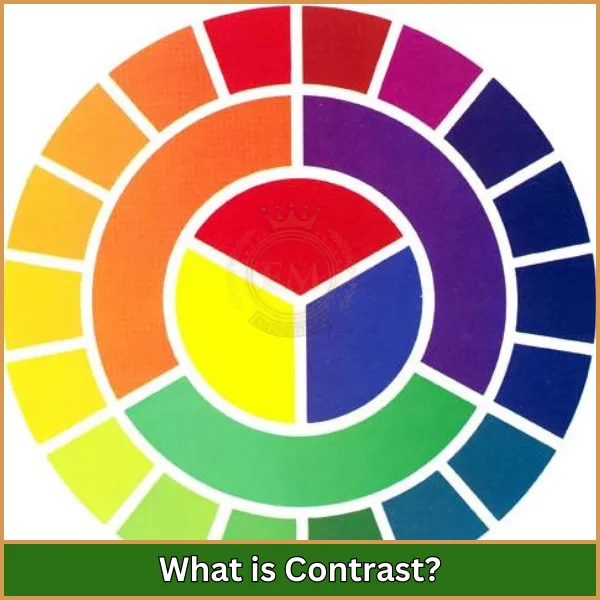
Si riferisce alla differenza tra due colori o elementi nel tuo design. It helps highlight certain parts and draw the viewer’;s attenzione. Ecco alcuni modi per utilizzare il contrasto in modo efficace:
- Contrasto elevato: Utilizzando colori molto diversi tra loro, come il bianco e nero o il rosso e verde, crea un look sorprendente. Questo è ottimo per far risaltare dettagli specifici, soprattutto se si considera il contrasto e i colori complementari.
- Basso contrasto: Quando usi colori simili, come due sfumature di blu, il disegno appare più morbido e sfumato. Questo può creare un effetto calmo e armonioso.
Cos'è il valore?
Si riferisce a quanto è chiaro o scuro un colore. La regolazione del valore nel ricamo può aggiungere profondità e dimensione. Ecco come puoi utilizzare il valore nei tuoi progetti:
- Valori leggeri: Colori più chiari, come il giallo pallido o il rosa chiaro, creare una sensazione di apertura. Possono rendere il tuo design arioso e luminoso.
- Valori oscuri: Colori più scuri, come il blu navy o il verde scuro, aggiungere peso e profondità. Possono creare un aspetto più drammatico nei tuoi ricami.
Usare contrasto e valore insieme
Combinando contrasto e valore puoi creare il tuo disegni da ricamo più interessante. Per esempio, l'uso di un filo scuro su un tessuto chiaro crea un contrasto elevato, far risaltare il design. D'altro canto, l'utilizzo di thread di valori simili può creare un effetto più fluido, aspetto più integrato.
Impatto psicologico dei colori
Teoria dei colori è fondamentale per comprendere come i colori influenzano le nostre emozioni e percezioni. Quando si creano disegni da ricamo a macchina, recognizing how different colors can affect viewers’; i sentimenti sono essenziali. Ecco alcuni fattori importanti da considerare quando si sceglie la tavolozza dei colori:
Caldo contro. Colori freddi
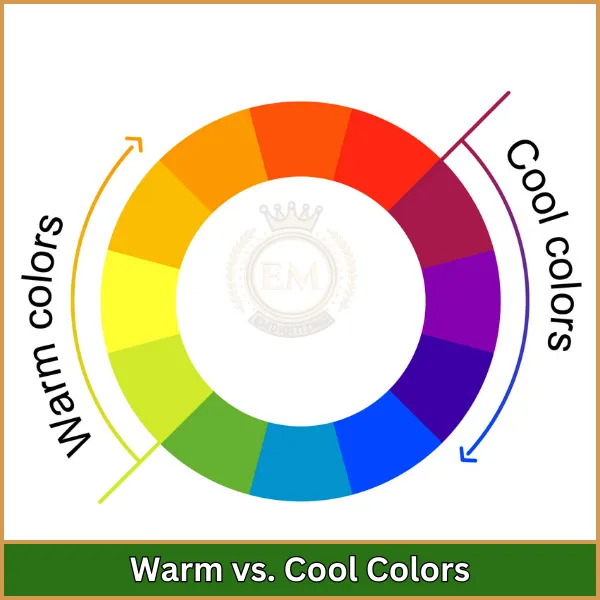
Colori caldi, come il rosso, arancia, e giallo, evocare sentimenti di energia ed eccitazione. Questi colori possono rendere i tuoi progetti vivaci e accattivanti. Per esempio:
- Rosso spesso rappresenta l'amore e la passione, rendendolo ideale per progetti che mirano a creare forti risposte emotive.
- Arancia trasmette calore e cordialità, perfetto per progetti allegri che invitano alla positività.
- Giallo porta luminosità e gioia, edificante gli spiriti ed evocando un senso di felicità.
D'altro canto, colori freddi come il blu, verde, e il viola creano un'atmosfera rilassante e pacifica. Queste sfumature possono conferire serenità ai tuoi progetti:
- Blu è associato alla tranquillità e alla fiducia, rendendolo un'ottima scelta per i progetti che devono promuovere rassicurazione.
- Verde simboleggia la natura e il rinnovamento, fornendo una sensazione rinfrescante ed equilibrata che può aiutare a ridurre lo stress.
- Viola è legato alla creatività e al lusso, aggiungendo eleganza al tuo ricamo e ispirando l'immaginazione.
Luminoso vs. Colori tenui
Colori vivaci, come il rosa neon o l'arancione vivido, sono accattivanti ed energizzanti. Sono perfetti per design vivaci che mirano ad attirare l'attenzione. In contrasto, colori tenui come il delicato lavanda o il verde salvia offrono un aspetto più sobrio e sofisticato. Questi toni più tenui possono creare un effetto calmante e trasmettere eleganza, rendendoli adatti a design sottili.
Associazioni di colori
Colori diversi portano significati specifici che possono migliorare il tema del tuo ricamo. Per esempio:
- Rosso è spesso associato a sentimenti forti come l'amore e il potere, rendendolo di grande impatto nel design.
- Blu significa fiducia e stabilità, rendendolo ideale per progetti professionali che ispirano fiducia.
- Verde rappresenta la crescita e l'armonia, perfetto per progetti a tema naturale che incoraggiano il relax.
Utilizzando la psicologia del colore nel ricamo, puoi assicurarti che i tuoi progetti comunichino efficacemente il messaggio previsto ed evochino le risposte emotive desiderate.
Simbolismo e cultura
I colori possono avere significati diversi nelle diverse culture. Ad esempio, mentre il bianco simboleggia spesso la purezza nelle società occidentali, potrebbe rappresentare il lutto in alcune culture orientali. Comprendere queste differenze culturali ti consente di scegliere colori che risuonano con il tuo pubblico e trasmettono il messaggio giusto, assicurandoti che i tuoi progetti siano significativi e appropriati.
Impatto emotivo
I colori hanno un impatto significativo sui nostri sentimenti. Ad esempio, mentre il blu può creare un senso di calma, il rosso può evocare eccitazione o addirittura rabbia. Scegliere i colori che corrispondono al tono emotivo del tuo design è fondamentale per lasciare un'impressione duratura. Comprendendo questi effetti psicologici, puoi prendere decisioni più informate nella selezione del colore del filo da ricamo e applicare in modo efficace la teoria dei colori per migliorare i tuoi disegni!
Tecniche per la fusione dei colori nella digitalizzazione
Tecniche di fusione dei colori dei fili sono cruciali digitalizzazione del ricamo, aggiungendo profondità e dimensione ai progetti. Combinando diverse sfumature e tonalità, puoi creare transizioni fluide tra i colori, dando al tuo ricamo un aspetto più dinamico e realistico. Ecco alcune tecniche efficaci per la fusione dei colori:
1. Miscelazione gradiente
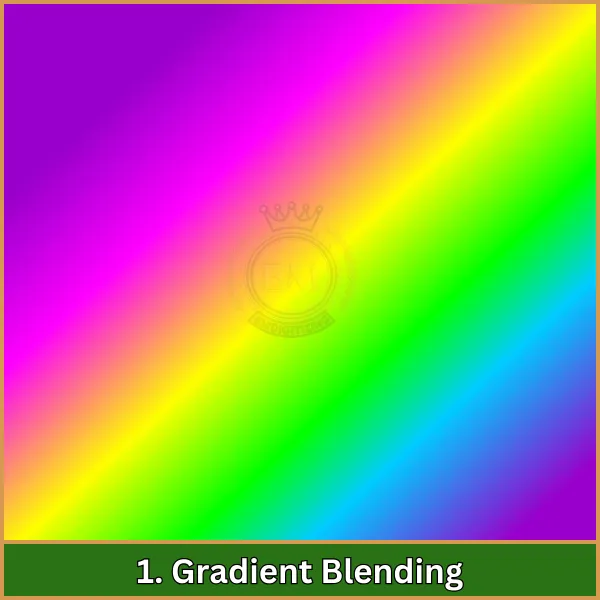
La fusione sfumata comporta la transizione graduale da un colore all'altro. Questa tecnica è particolarmente utile per creare effetti naturali, come cieli o paesaggi. Per esempio, potresti sfumare dal blu chiaro in alto al blu più scuro in basso per imitare la profondità del cielo.
2. Miscelazione a strati
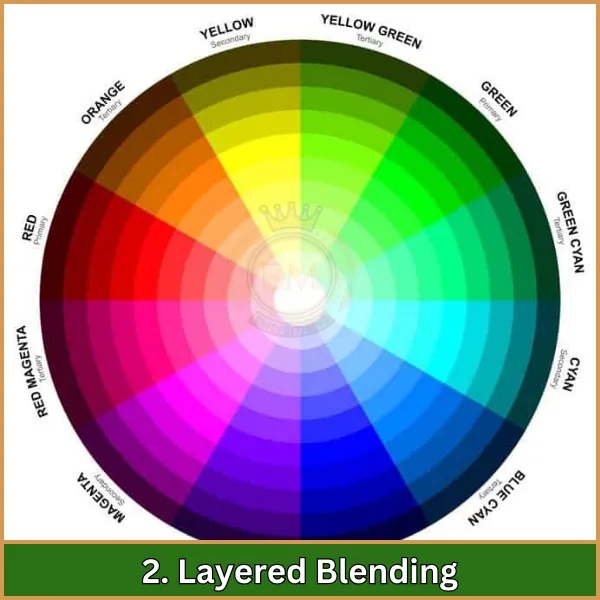
In miscelazione a strati, colori diversi vengono cuciti uno sopra l'altro per produrre un effetto di fusione graduale.
Questo metodo è ideale per i progetti che richiedono sottili variazioni di colore, come motivi floreali o pellicce di animali.
Stratificando i colori, puoi creare una trama ricca e aggiungere complessità ai tuoi progetti.
3. Miscelazione a punto croce
Questa tecnica prevede l'utilizzo di due diversi colori di filo nel punto croce per creare miscele complesse. È particolarmente efficace per aggiungere dettagli e texture agli elementi fini del tuo design, come ombreggiature di fiori o motivi di tessuti. Il metodo del punto croce può rendere il tuo ricamo più strutturato e vivace.
4. Miscelazione delle ombre
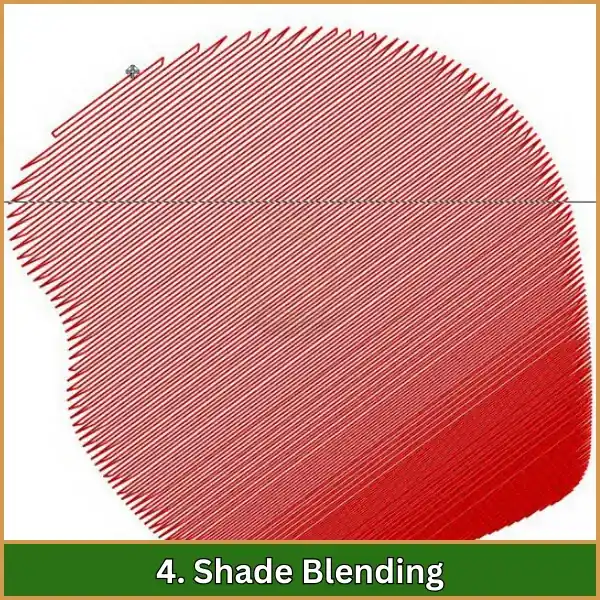
La fusione delle ombre si concentra sulla transizione graduale tra diversi valori dello stesso colore.
Questa tecnica è utile per creare profondità nei tuoi progetti, come l'evidenziazione e l'ombreggiatura.
Ad esempio, passare da un verde scuro a un verde chiaro può aiutare a dare l'impressione di profondità nel fogliame.
5. Estrazione del colore
L'estrazione del colore è una tecnica in cui il macchina da ricamo tira leggermente il filo durante la cucitura per creare un aspetto misto. Questa tecnica può ammorbidire i bordi tra due colori, fornendo una transizione graduale che può migliorare l'aspetto generale del design.
6. Uso del filo variegato
Il filo variegato contiene più colori in un unico filo, consentendo la fusione automatica mentre cuci. Questa tecnica è comoda e aggiunge un tocco unico ai tuoi progetti, creare bello, effetti miscelati senza la necessità di cambi di colore manuali.
7. Regolazione della densità del punto
La modifica della densità dei punti può influenzare il modo in cui i colori si fondono nel tuo disegno. Una densità più elevata può comportare una miscela di colori più pronunciata, mentre una densità inferiore può creare un effetto più morbido, effetto più sottile. La regolazione della densità dei punti consente flessibilità creativa nel raggiungere l'aspetto desiderato.
Conclusione
Imparare la teoria dei colori in ricamo a macchina è un modo divertente per rendere i tuoi progetti ancora migliori. Quando sai come i colori lavorano insieme e quali sensazioni possono creare, puoi scegliere i colori più adatti ai tuoi progetti. Questo aiuterà i tuoi ricami ad avere un aspetto fantastico!
Se hai bisogno di aiuto con il ricamo, dai un'occhiata ai nostri servizi su EMDigitalizzazione. Lavoriamo velocemente, avere buoni prezzi, e assicurati che i tuoi progetti siano davvero di alta qualità.
E indovina cosa? Se sei un nuovo cliente, ottieni 50% fuori dal tuo primo ordine! Lascia che ti aiutiamo a realizzare le tue idee di ricamo!
Domande frequenti
Le tre teorie fondamentali del colore sono l’armonia dei colori, la ruota dei colori, e contesto di colore. Queste teorie aiutano a creare strutture cromatiche logiche ed efficaci nei progetti.
Quando si scelgono i colori per il ricamo, considerare il colore del tessuto, poiché influisce sulle scelte di colore. È possibile utilizzare la ruota dei colori per facilitare la selezione di un colore. Inoltre, guardati intorno per trovare ispirazione; troverai molte fantastiche combinazioni di colori nella natura e nel tuo ambiente. Fidati della tua esperienza, poiché spesso vengono in mente certe combinazioni di colori quando si pensa ai design.
I colori svolgono un ruolo cruciale nell'aggiungere profondità e dettaglio ai disegni di ricamo. Per progetti 3D, il posizionamento dei colori è importante. Combinando colori chiari e scuri, puoi creare dimensione e profondità, rendendo il tuo design più visivamente accattivante.
Color theory is the study of how different color combinations look and how they affect people’;s sentimenti e percezioni. È uno strumento importante per i designer, artisti, e creatori di ricami perché li aiuta a scegliere i colori giusti per i loro progetti.
La teoria dei colori è importante perché i colori possono avere un forte impatto sulle emozioni e sulle decisioni delle persone. Secondo la psicologia del colore, le combinazioni di colori possono influenzare le nostre scelte di acquisto ed evocare reazioni emotive. Capire questo può aiutarti a creare design più efficaci e accattivanti.
